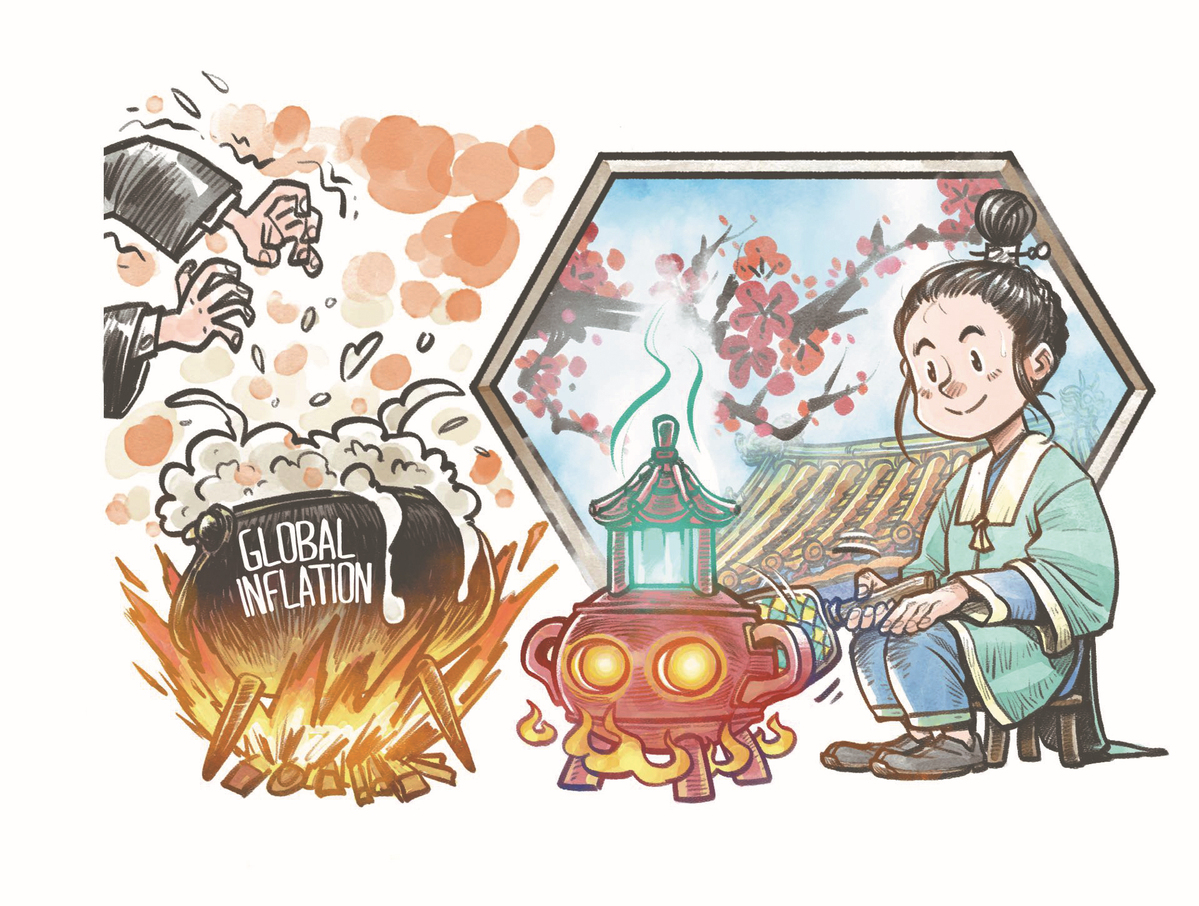
2021年以來國際通脹水平明顯上行,特別是今年以來國際通脹水平進(jìn)一步快速上行,美歐等經(jīng)濟(jì)體物價(jià)連續(xù)創(chuàng)下多年或歷史新高。得益于疫情防控得當(dāng)、社會(huì)生產(chǎn)秩序穩(wěn)定、宏觀政策力度節(jié)奏把握精準(zhǔn),中國物價(jià)一直運(yùn)行在總體合理區(qū)間,對(duì)穩(wěn)定全球物價(jià)發(fā)揮了積極作用。

Inflation" has gradually become a buzzword in business and economic circles since 2021. In April, the year-on-year growth rates of the Consumer Price Index (CPI) and Producer Price Index (PPI) in the United States rose 8.3 percent and 11.0 percent, respectively. Right now the US CPI and PPI are still at four-decade high levels.
自2021以來,“通貨膨脹”逐漸成為商界和經(jīng)濟(jì)界的熱門詞匯。4月份,美國消費(fèi)者價(jià)格指數(shù)(CPI)和生產(chǎn)者價(jià)格指數(shù)(PPI)同比增長率分別上升8.3%和11.0%。目前,美國的CPI和PPI仍處于40年來的高位。
Europe is even worse in terms of inflation as European Union member states face energy shortages and geopolitical tensions triggered by the Russia-Ukraine conflict.
由于歐盟成員國面臨能源短缺和俄烏沖突引發(fā)的地緣政治緊張局勢(shì),歐洲的通貨膨脹情況更為嚴(yán)重。
A combination of factors has contributed to the high inflation rates, including policy factors, supply issues and geopolitics, to name just a few.
政策因素、供應(yīng)鏈問題和地緣政治等多重因素共同導(dǎo)致了高通脹率。
After the outbreak of the COVID-19 pandemic in late 2019, many countries adopted expansionary monetary and fiscal policies. Take the US as an example. Government departments launched a series of stimulus policies, including both monetary and fiscal policies in response to COVID-19. In March 2020, the year-on-year growth rate of the broad money supply (M2) rose from 6.7 percent to 10.2 percent, reaching a peak of 26.9 percent in February 2021. In addition, the Federal Reserve Board has also stimulated the economy through reducing interest rates and practicing quantitative easing.
2019年末新冠疫情暴發(fā)后,許多國家采取了擴(kuò)張性貨幣和財(cái)政政策。以美國為例,為了應(yīng)對(duì)疫情,美國政府推出了一系列刺激政策,包括貨幣和財(cái)政政策。2020年3月,廣義貨幣供應(yīng)量(M2)同比增長率從6.7%升至10.2%,2021年達(dá)到26.9%的峰值。此外,美聯(lián)儲(chǔ)委員會(huì)還通過降息和實(shí)行量化寬松政策刺激經(jīng)濟(jì)。
In terms of fiscal policy, the US government also introduced a series of stimulus programs. By early 2021, a number of fiscal stimulus policies were in place and paved the way for inflation. These programs involved a total amount of some $5 trillion, which was almost equal to a quarter of the US GDP in 2020. This is a striking stimulus program when we compare it to the Subprime Mortgage Crisis of 2007-2008. At that time, the Obama Administration's fiscal stimulus policy stood at around $787 billion, which amounted to 5.4 percent of the US GDP in 2008. There is no doubt that US monetary and fiscal policies and the accompanying tremendous liquidity are very important causes of inflation in the US and the world as well.
美國政府還推出了一系列財(cái)政刺激計(jì)劃。到2021年初,許多財(cái)政刺激政策已經(jīng)落實(shí),為通貨膨脹鋪平了道路。這些刺激計(jì)劃共涉及約5萬億美元,幾乎相當(dāng)于2020年美國國內(nèi)生產(chǎn)總值(GDP)的四分之一。與2007-2008年的次貸危機(jī)相比,這些刺激計(jì)劃相當(dāng)驚人。當(dāng)時(shí),奧巴馬政府的財(cái)政刺激政策約為7870億美元,相當(dāng)于2008年美國GDP的5.4%。毫無疑問,美國的貨幣和財(cái)政政策以及因此引發(fā)的巨大流動(dòng)性是導(dǎo)致美國和全球通脹的重要原因。
Other developed countries have also adopted similar stimulus policies. The money supply grew at a peak rate of 12.4 percent in the eurozone in January 2021. Another factor that must be kept in mind is the Russia-Ukraine conflict, as it can lead to potential energy shortages, which further exacerbate inflation in the EU. As can be seen from statistics, the EU's PPI was as high as 31.5 percent and 36.8 percent in March and April 2022. Even the CPI, which rose relatively slower, reached 7.4 percent in April.
其他發(fā)達(dá)國家也采取了類似的刺激政策。2021年1月,歐元區(qū)的貨幣供應(yīng)量增長率達(dá)到了12.4%的峰值。俄烏沖突是另一個(gè)必須關(guān)注的因素,因?yàn)檫@場沖突可能導(dǎo)致潛在的能源短缺,從而進(jìn)一步加劇歐盟的通貨膨脹。從統(tǒng)計(jì)數(shù)據(jù)可以看出,2022年3月和4月,歐盟的PPI分別高達(dá)31.5%和36.8%。即使是漲幅相對(duì)較慢的CPI在4月份也達(dá)到了7.4%。
Japan also adopted an extremely expansionary monetary policy. Even in April, when the US and other countries began to raise their interest rates, the Bank of Japan still stuck to an expansionary monetary policy. To achieve an expansionary effect, the BOJ continues to buy government bonds in order to suppress the interest rates of Japanese government bonds, thus injecting more liquidity into the market.
日本同樣采取了極具擴(kuò)張性的貨幣政策。今年4月,當(dāng)美國和其他國家開始加息時(shí),日本央行仍堅(jiān)持?jǐn)U張性貨幣政策。為了實(shí)現(xiàn)擴(kuò)張效應(yīng),日本央行繼續(xù)購買國債,從而向市場注入更多流動(dòng)性。
In short, the expansionary monetary policies of the world's major developed countries are an important reason for the current global inflation.
總之,世界主要發(fā)達(dá)國家的擴(kuò)張性貨幣政策是當(dāng)前全球通貨膨脹的重要原因。
The disruption of supply chains caused by COVID-19 is another important reason for global inflation. At the beginning of the COVID-19 pandemic, many countries around the world held a "wait and see" attitude, which led to even more serious spread of the contagion. The spread of the virus led to the cessation of production in some areas and subsequent serious shortages of supplies. That said, the labor shortages caused supply shocks. When demand recovers quickly but supply recovers more slowly, inflation occurs. COVID-19 has also led to chaos in transportation services, with rising freight prices and tight capacity, and this phenomenon has also pushed up global inflation.
新冠疫情導(dǎo)致的供應(yīng)鏈中斷是全球通貨膨脹的另一個(gè)重要原因。在新冠疫情暴發(fā)之初,世界上許多國家都持“觀望”態(tài)度,這導(dǎo)致了疫情更為嚴(yán)重的傳播。病毒傳播導(dǎo)致一些地區(qū)停產(chǎn),隨后供應(yīng)嚴(yán)重短缺。也就是說,勞動(dòng)力短缺造成了供應(yīng)沖擊。當(dāng)需求迅速恢復(fù),但供應(yīng)恢復(fù)較慢時(shí),就會(huì)發(fā)生通貨膨脹。疫情還擾亂了運(yùn)輸業(yè),貨運(yùn)價(jià)格上漲,運(yùn)力緊張,這一現(xiàn)象也推高了全球通脹。
The Russia-Ukraine conflict that broke out in February is exacerbating the problem of global inflation. The conflict directly leads to global energy jitters. NYMEX crude oil was $95.72 per barrel on Feb 28, just as the hostilities began. On March 7, the price rose to $130.50 per barrel, which is the highest level since August 2008. For US CPI data, the sub-item "Energy" (fuel, electricity and gasoline) prices rose by as much as 32.0 percent and 30.3 percent, year-on-year, in March and April. Another sub-item, "Transportation "increased 22.6 percent and 19.9 percent, respectively.
今年2月爆發(fā)的俄烏沖突加劇了全球通脹問題。這場沖突直接導(dǎo)致全球能源緊張。就在沖突爆發(fā)之初,2月28日紐約商品交易所原油價(jià)格為每桶95.72美元。3月7日,油價(jià)上升至每桶130.50美元,為2008年8月以來的最高水平。美國CPI數(shù)據(jù)顯示,3月和4月,“能源”(燃料、電力和汽油)分項(xiàng)價(jià)格同比分別上漲32.0%和30.3%。另一個(gè)分項(xiàng)“運(yùn)輸”分別增長22.6%和19.9%。
The Russia-Ukraine conflict has had an impact on minerals and agricultural products. Since the outbreak of the Russia-Ukraine conflict, prices of aluminum, nickel and copper have risen significantly. As an important food-producing region in the world, Ukraine's agricultural production and exports have also been greatly affected. Global supplies of wheat, sunflower oil and other agricultural products have been seriously disrupted. Food prices are also an important part of the CPI, and the Russia-Ukraine conflict has undoubtedly contributed to the rise of global food prices.
俄烏沖突對(duì)礦產(chǎn)和農(nóng)產(chǎn)品市場也產(chǎn)生了影響。自沖突爆發(fā)以來,鋁、鎳和銅的價(jià)格大幅上漲。作為世界上重要的糧食生產(chǎn)地區(qū),烏克蘭的農(nóng)業(yè)生產(chǎn)和出口也受到了很大影響。全球小麥、葵花籽油和其他農(nóng)產(chǎn)品的供應(yīng)已被嚴(yán)重?cái)_亂。食品價(jià)格也是CPI的重要組成部分,俄烏沖突無疑是導(dǎo)致全球食品價(jià)格上漲的原因之一。
In China, COVID-19 is increasingly coming under better control because of appropriate prevention policies. The industrial chain operates regularly, and the supply shock is relatively muted compared with other countries. In 2020 and 2021, the value of foreign direct investment (FDI) inflows to China was $163 billion and $173 billion, respectively. Foreign capital flowed into China to take advantage of its potential. These FDI statistics reflect the stable business environment in China and how foreign companies vote with their money and strategies.
在中國,由于政府采取了適當(dāng)?shù)姆揽卣撸咔橹饾u得到有效控制。產(chǎn)業(yè)鏈運(yùn)行正常,與其他國家相比,供應(yīng)沖擊相對(duì)較小。2020年和2021年,流入中國的外國直接投資(FDI)分別為1630億美元和1730億美元。外國資本流入中國是看中了中國市場的潛力。FDI統(tǒng)計(jì)數(shù)據(jù)反映出中國營商環(huán)境穩(wěn)定,也反映出外國企業(yè)如何用資金和決策表明他們的立場。
The Chinese government also adopted expansionary monetary and fiscal policies in 2020. However, when compared with other countries, China's policies were relatively mild. Actually, the growth rate of the M2 hit a peak of 11.1 percent in May and June 2020, and began to decrease gradually after that time. In comparison with the US and EU, China's CPI and PPI are relatively low. In April, China's CPI growth was 2.1 percent. Although the PPI's growth rate was still high at 8.0 percent, this can be seen as the result of the growing price of global commodities to a greater extent.
2020年,中國政府也采取了擴(kuò)張性貨幣和財(cái)政政策。然而,與其他國家相比,中國的政策相對(duì)溫和。實(shí)際上,M2的增長率在2020年5月和6月達(dá)到了11.1%的峰值,之后開始逐漸下降。與美國和歐盟相比,中國的CPI和PPI相對(duì)較低。4月份,中國的CPI增長率為2.1%。盡管PPI的增長率仍高達(dá)8.0%,但這可以看作是全球大宗商品價(jià)格不斷更大幅度上漲的結(jié)果。
On the whole, the Chinese government has been doing well in controlling inflation. China does not "export" inflation. In contrast, China is playing a positive role in reducing global inflation and stabilizing global prices.
總的來說,中國政府在控制通貨膨脹方面表現(xiàn)出色。中國不“出口”通貨膨脹。相比之下,中國在緩和全球通貨膨脹和穩(wěn)定全球價(jià)格方面發(fā)揮著積極作用。
來源:中國日?qǐng)?bào)
作者:Zhou Xuezhi, Pan Yuanyuan
編譯:董靜
The views don't necessarily reflect those of China Daily.
The writers are Zhou Xuezhi, assistant research fellow of the Institute of World Economics and Politics, Chinese Academy of Social Sciences, and Pan Yuanyuan, associate research fellow of the institute at the CASS.
